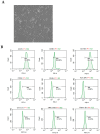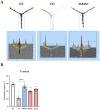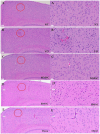Multipotent Mesenchymal Stem Cell Therapy for Vascular Dementia
- PMID: 40358180
- PMCID: PMC12071514
- DOI: 10.3390/cells14090651
Multipotent Mesenchymal Stem Cell Therapy for Vascular Dementia
Abstract
Vascular dementia (VD), characterized by cognitive decline and behavioral disorders, has seen a rapid increase in prevalence in recent years. However, effective treatments for VD remain unavailable. Due to its regenerative potential, stem cell therapy has garnered attention as a promising approach for VD treatment, yet it has shown limited effects on cognitive and behavioral impairments caused by the disease. To address this limitation, this study aimed to develop a novel treatment using human embryonic stem cell-derived multipotent mesenchymal stem cells (MMSCs). The therapeutic efficacy of MMSCs was evaluated using a vascular dementia mouse model induced by bilateral carotid artery stenosis (BCAS). The effects of MMSCs were assessed through behavioral tests and postmortem brain tissue analysis, including mRNA expression analysis and hematoxylin and eosin (H&E) staining. MMSCs treatment significantly improved both working memory and long-term memory. Histological analysis revealed enhanced angiogenesis, preservation of blood-brain barrier integrity, and improved hippocampal organization. Furthermore, MMSCs treatment reduced the expression of Rock1/2, indicating suppression of neuroinflammatory and apoptotic pathways. These findings suggest that MMSCs offer a sustainable and effective therapeutic approach for vascular dementia.
Keywords: carotid stenosis; cognitive dysfunction; conduct disorder; human embryonic stem cells; stem cells; vascular dementia.
Conflict of interest statement
Authors Eun-Young Kim, Ki-Sung Hong, Hyung-Min Chung, Se-Pill Park were employed by the company Miraecellbio Co., Ltd. The remaining authors declare that the research was conducted in the absence of any commercial or financial relationships that could be construed as a potential conflict of interest. The company had no role in the design of the study; in the collection, analyses, or interpretation of data; in the writing of the manuscript, or in the decision to publish the results.
Figures







References
Publication types
MeSH terms
LinkOut - more resources
Full Text Sources

